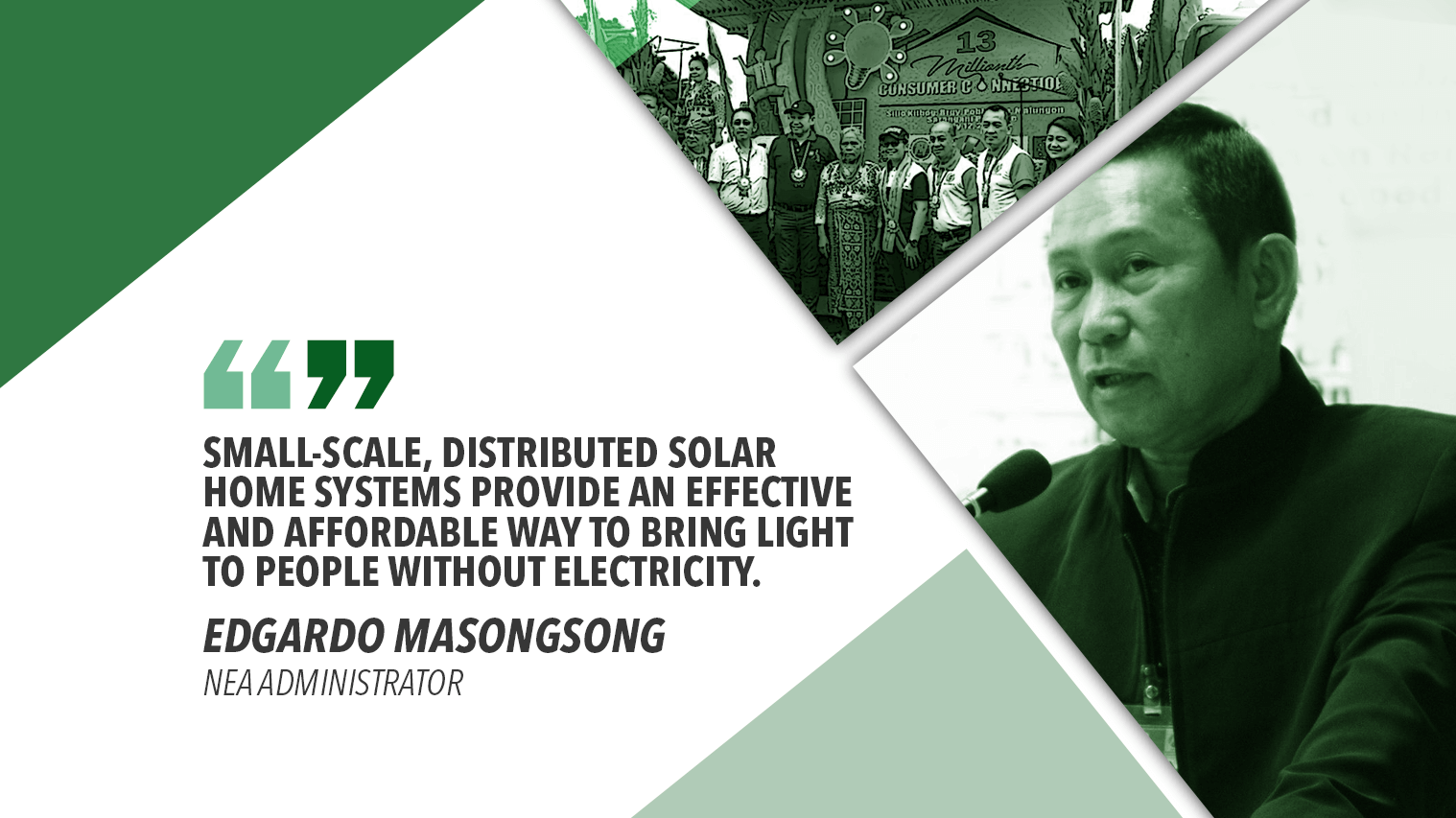Despite light rain and muddy terrain, officials of the National Electrification Administration (NEA) made it to the upland villages of Malungon town in Sarangani to mark the official energization of the 13 millionth household consumer connection of electric cooperatives (ECs) in the country.
NEA Administrator Edgardo Masongsong went to one of the farthest off-grid communities of the province on Friday (July 12) to lead the ceremonial switch-on of the solar home systems (SHS) distributed to the residents of Sitio Kitbog in Barangay Poblacion.
This is a first in the history of rural electrification, as the million milestone household connections the NEA and its partner ECs celebrated in the past were all connected to power distribution grids.
“Though small in power, solar home systems can bring immense changes to the lives of the people it serves.”
Feliza Pangilan, a 76-year old farmer and a member of the B’laan tribe, is the 13-millionth EC member-consumer-owner under the care of the South Cotabato II Electric Cooperative, Inc. (SOCOTECO-II).
Pangilan’s house, which sits on a mountainous landscape, is now brightened by a basic SHS unit equipped with a small solar panel, battery, charge controller, LED lights, transistor radio and a universal outlet for charging mobile phones.
Masongsong admitted that bringing power to the hardest-to-reach “last mile” communities is not an easy task, as logistical, financial and topographical problems in the implementation of the rural electrification program remain across the country.
“This magnifies the biggest challenge we are facing to achieve the target of 100 percent total household electrification by 2022, since the Philippines is an archipelagic country,” he said in his speech.
But with the support of the national government and international agencies, NEA continues to explore different strategies such as establishing mini-grids and providing small-scale power solutions to extend electrification services to other missionary areas.
Electrifying Sitio Kitbog was made possible under the Photovoltaic Mainstreaming Program of the Department of Energy (DOE) funded by the European Union-Access to Sustainable Energy Programme (EU-ASEP) through World Bank.
“This magnifies the biggest challenge we are facing to achieve the target of 100 percent total household electrification by 2022.”
As an attached agency of the DOE, the NEA administered the project across Mindanao through its partnership with the ECs. Around 2,500 households in Malungon, including Pangilan, benefitted from the program with the assistance of SOCOTECO-II.
“Small-scale, distributed solar home systems provide an effective and affordable way to bring light to people without electricity… Though small in power, solar home systems can bring immense changes to the lives of the people it serves,” Masongsong said.
Before electricity, Pangilan used torches for lighting. After decades of living in the dark, she is now grateful for the solar panels that light up not only her home but that of her neighbors’ as well.
Speaking in her Sarangani B’laan language, Pangilan thanked the NEA, DOE, SOCOTECO-II and everyone involved in the project for choosing their community as among the beneficiaries of the ASEP in the country.
SOCOTECO-II general manager Crisanto Sotelo, meanwhile, is proud to have been part of this milestone in the history of rural electrification, adding that his EC remains committed to improve on its 63-percent electrification level.
The non-profit distribution utility serves General Santos City, Sarangani, and the municipalities of Tupi and Polomolok in South Cotabato. SOCOTECO-II plans to issue additional 7,500 SHS units to other remote households within its franchise area.
For her part, Malungon Mayor Maria Theresa Constantino also expressed gratitude to SOCOTECO-II and the national government for reaching out to the indigenous communities of her municipality and helping to address their needs.
“We will be responsible for the sustainability of this program. And by sustaining this, God will be glorified, he will pour out blessings upon this town,” she said, hoping that more social projects will come to Malungon for its development.
Malungon, incidentally, celebrates its 50th founding anniversary this year just like the NEA. For the past five decades, the rural electrification agency and its partner ECs have energized a total of 90 cities, 1,385 municipalities and 36,057 barangays nationwide.
Based on a 2015 census of 15,416,144 potential households, 85 percent or 13,027,402—translating to nearly 61 million Filipinos in the countryside—are currently enjoying the benefits of electricity.

